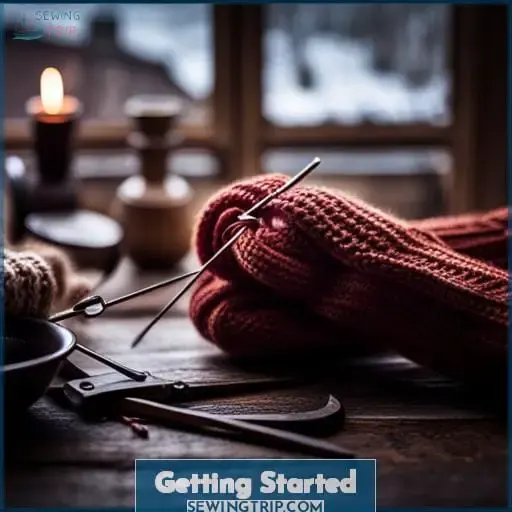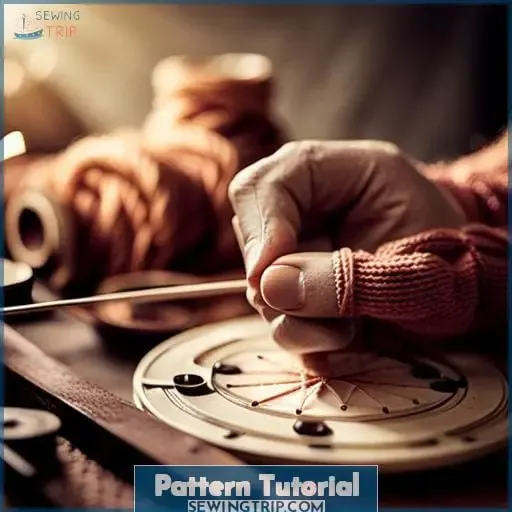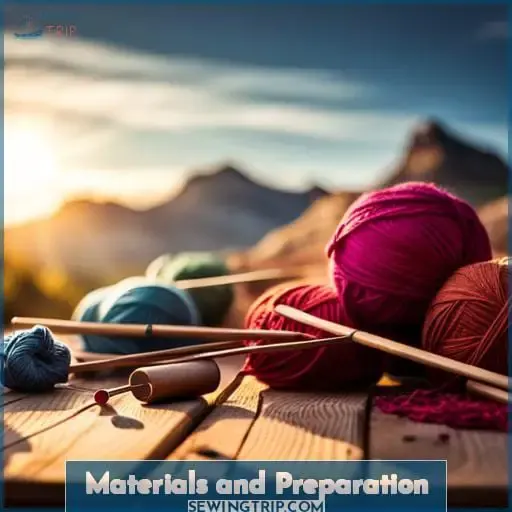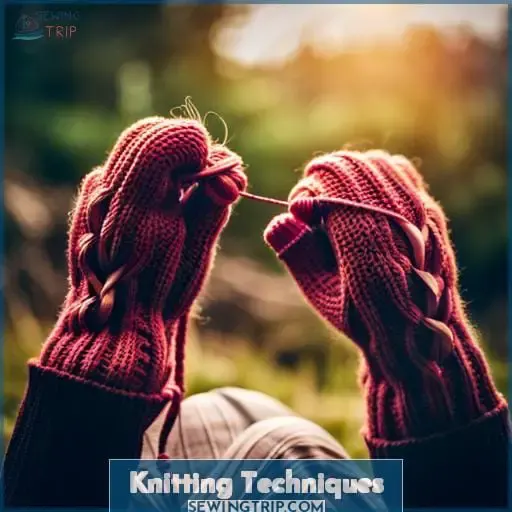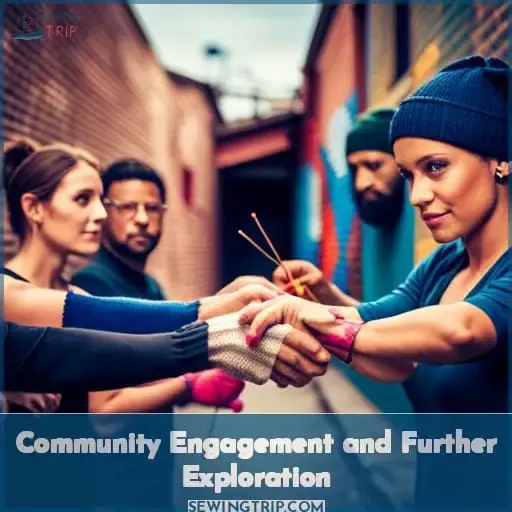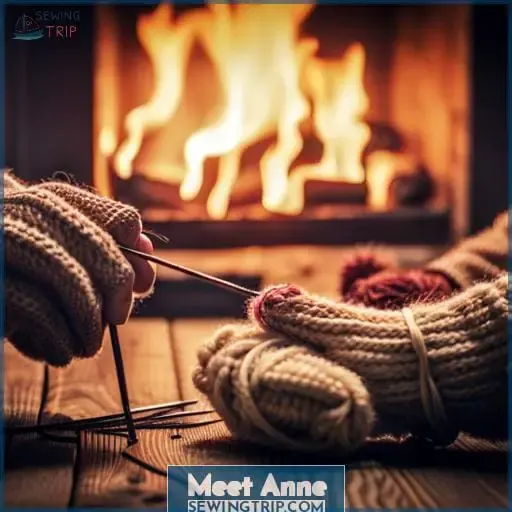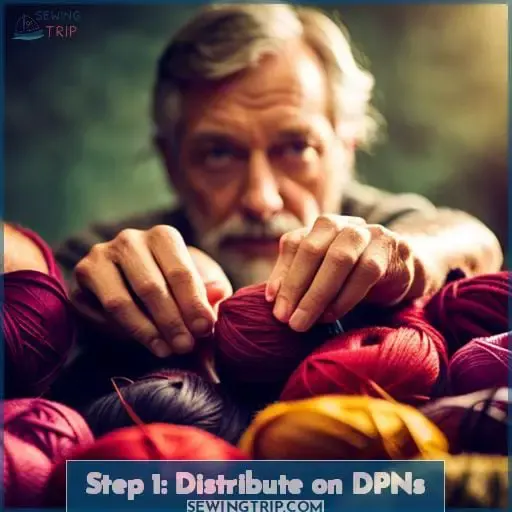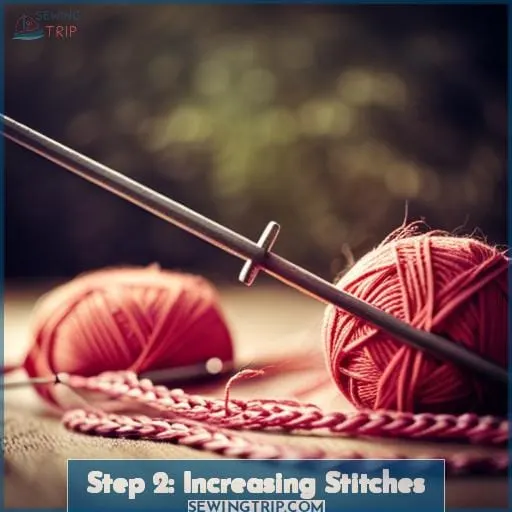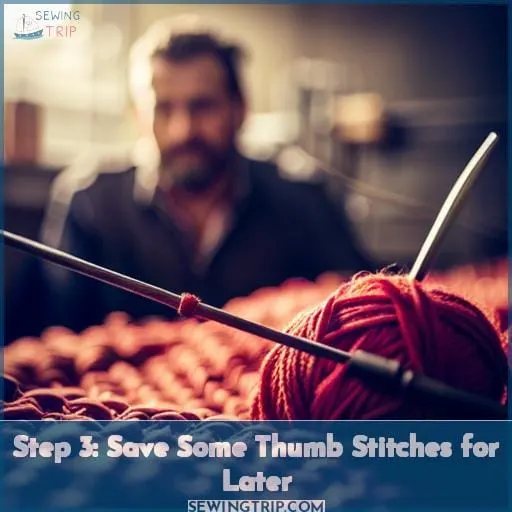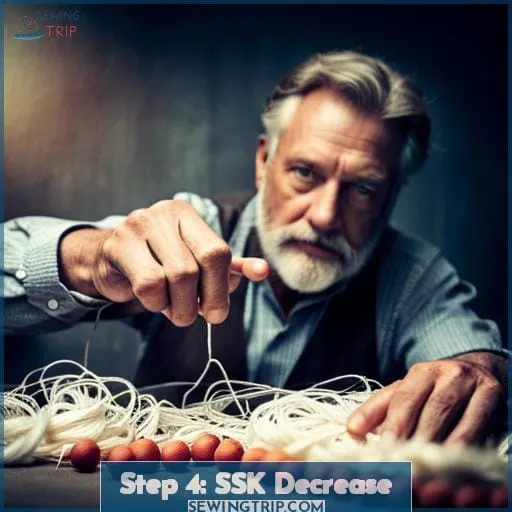This site is supported by our readers. We may earn a commission, at no cost to you, if you purchase through links.
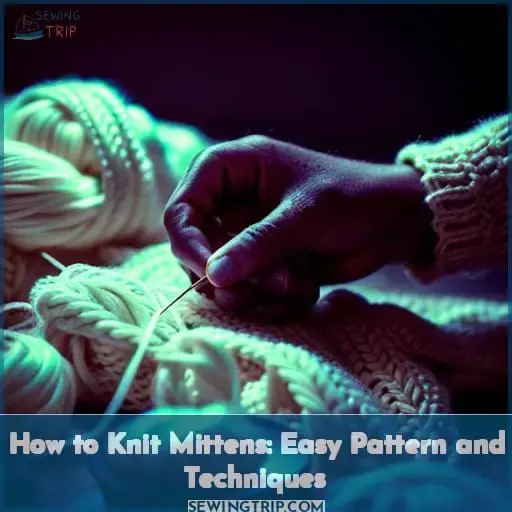 Imagine yourself curled up on a cozy couch, with a cup of hot cocoa in hand and snow gently falling outside.
Imagine yourself curled up on a cozy couch, with a cup of hot cocoa in hand and snow gently falling outside.
In this easy pattern and technique guide, we’ll show you how to knit your own mittens. From choosing the right needles to mastering essential knitting techniques, get ready to create stylish and snug accessories that will have everyone asking where you got them from.
Let’s dive into the world of mitten knitting together!
Table Of Contents
Key Takeaways
- Consider the thickness and warmth of yarn when choosing materials for knitting mittens.
- Learn and practice different knitting techniques such as ribbing and shaping to create well-fitted mittens.
- Explore different needle options like DPNs or the Magic Loop technique to find the best method for your knitting style.
- Engage with online communities and social media platforms to connect with other knitters, share projects, and gain inspiration.
Getting Started
To begin knitting mittens, gather your materials and prepare for an enjoyable crafting experience.
Yarn choices are crucial in creating cozy and warm mittens. Consider the weight of the yarn – fingering, DK, worsted, or chunky – to ensure the desired thickness and warmth.
Next comes needle selection; choose between double-pointed needles (DPNs) or using the Magic Loop technique for knitting in the round. Pay attention to gauge importance by checking your stitches per inch with a stockinette stitch swatch before starting your project; this ensures that you achieve accurate sizing for your mittens.
When it comes to ribbing techniques, follow specific instructions provided in patterns as they may vary based on design preferences. Experiment with different methods such as K1,P1 ribbing or other variations depending on personal style.
Lastly,you may be wondering about which method is best: Magic Loop vs.DPNs? Both techniques have their advantages so feel free to explore both options through tutorials.
Pattern Tutorial
In the Pattern Tutorial, you’ll learn step-by-step instructions for knitting mittens with ease and confidence. This tutorial will guide you through every stage of creating your own cozy pair of mittens.
We’ll start by discussing yarn selection, helping you choose the perfect color and weight to suit your preferences and climate.
Next, we’ll delve into needle choices, exploring different options such as double-pointed needles or Magic Loop technique.
As we progress through the pattern, we’ll also cover pattern modifications that allow for customization based on size or personal style.
If any challenges arise along the way, don’t worry! Our troubleshooting tips will help you overcome common pitfalls and ensure smooth sailing throughout your mitten-knitting journey.
With this comprehensive tutorial in hand (or needles!), you can confidently embark on knitting a beautiful pair of mittens that fit perfectly and keep your hands warm during chilly days ahead.
So grab some yarn in your favorite colors, gather up those trusty knitting needles – it’s time to get started on this exciting project!
Materials and Preparation
For the materials and preparation of knitting mittens, gather:
- 2 balls of Patons Classic Wool Bulky in Dark Gray Ragg
- U.S. 10 (6mm) and U.S. 10½ (6.5 mm) knitting needles
The choice of yarn is crucial for creating cozy mittens that keep your hands warm during chilly days. Patons Classic Wool Bulky is an excellent option due to its suitability and luxurious feel against the skin.
When selecting needle sizes, it’s important to consider gauge accuracy to ensure a proper fit for your mittens. Take note of the recommended gauge provided in the pattern instructions or make a swatch beforehand to check if you need to adjust your needle size.
Additionally, don’t forget about color combinations! Get creative with different shades from Patons Classic Wool Bulky range or experiment with contrasting colors for unique mitten designs.
In terms of project organization, have all necessary tools at hand such as a yarn needle for finishing touches and double-pointed needles specifically designed for working small circumference projects like mittens.
Remember also that thumb stitches will be put on hold temporarily using waste yarn until they’re worked later on in the pattern.
Now that you’re prepared with all materials needed let’s dive into how easy it can be knit these cozy accessories!
Knitting Techniques
You’ll master essential knitting techniques for mittens with ease.
To create a beautiful pair of cozy mittens, it’s important to focus on purl mastery and knit efficiency. Achieving even tension throughout your work will ensure consistent stitches and neat results.
As you embark on your mitten-knitting journey, consider exploring different yarn options. Yarn exploration allows you to experiment with colors, weights, and fibers that best suit your style and preferences.
When working on the mittens’ thumb increase section, stitch markers become crucial in keeping track of each round. Additionally, using the magic loop technique or double-pointed needles can provide flexibility depending on your comfort level.
To shape the top of the mitten effectively while maintaining symmetry, incorporating decreases such as k2tog (knit two together) is key. This technique ensures a snug fit at the fingertips while adding an element of elegance to your finished project.
By mastering these knitting techniques—purling like a pro, achieving efficient knits with proper tension—it won’t be long before you’re creating beautifully crafted mittens that keep hands warm during chilly days ahead!
Community Engagement and Further Exploration
Connect with a community of like-minded knitters and explore further possibilities by sharing your progress in the private Facebook Group.
Engaging with others who share your passion for knitting can be an incredibly rewarding experience. Not only will you find support and encouragement, but you’ll also have the opportunity to learn from their experiences and gain valuable insights into different yarn varieties, color choices, knitting challenges, and more.
By joining this vibrant online community, you can exchange tips and tricks on everything from hand techniques to mastering thumb stitches. Whether you’re a beginner or an experienced knitter looking for inspiration or guidance, this group offers a safe space where everyone is welcome.
Additionally, project sharing allows you to showcase your creations while providing inspiration for others embarking on their own knitting journeys. Share photos of your finished mittens or works-in-progress as well as any helpful tips that may benefit fellow members.
Furthermore, circular needles are often used in mitten patterns due to their flexibility when working small circumference projects such as mittens. These needles allow easy transition between knit stitches without needing double pointed needles.
It’s important however, to choose circulars with lengths appropriate for the size of mitten being knit.
Connecting through social media platforms not only fosters connection but also opens up opportunities beyond just one-on-one interactions.
Meet Anne
Now let’s delve into the world of Anne, the creative mind behind Flax & Twine.
Anne isn’t just a knitter or designer; she’s an artist who weaves her passion for crafting into every stitch. Her inspiration comes from nature, colors, and textures that surround her. With each project she undertakes, whether it’s a cozy sweater or intricate shawl, Anne pours her heart and soul into creating beautifully crafted creations.
Anne’s handmade journey began as an escape from the corporate world of investment banking. Seeking solace in knitting needles and yarns led to a profound transformation in her life. She discovered joy in bringing ideas to life through knitting and found purpose in sharing this art with others.
Anne’s design philosophy revolves around simplicity – finding beauty in clean lines and uncomplicated patterns that allow both beginners and experienced knitters to create something extraordinary. Her creative process involves meticulous planning combined with spontaneous bursts of creativity.
As you follow along on your mitten-making adventure guided by Anne’s expertise, you’ll come across terms like increases for shaping thumbs, using stitch holders or markers to keep track of stitches during transitions between sections – all part of mastering this craft under her guidance.
By embracing hand decreases at just the right moments throughout your project-whether it be mittens or any other knitwear-you’ll witness firsthand how these techniques contribute towards achieving mastery over knitting while feeling safe within a community where everyone belongs.
Step 1: Distribute on DPNs
To begin knitting your mittens, distribute the stitches onto double-pointed needles (DPNs). This step is crucial for maintaining the correct stitch count and ensuring that your mitten turns out just right.
Take care to evenly divide the stitches across three or four DPNs, depending on your pattern’s instructions.
Needle placement plays a key role in achieving an even tension throughout your work. By distributing the stitches onto multiple DPNs, you can avoid any tightness or strain that might occur if all of the stitches were crowded onto one needle.
This allows for smoother knitting flow and ensures that each stitch receives equal attention.
As you distribute the stitches, be mindful of their position within each section of the mitten – cuff, thumb gusset area, hand section – as this will determine how they’re worked later on. Properly placing them now sets you up for success when it comes time to shape different parts of your mittens.
By following these steps and distributing your stitches strategically on DPNs with proper needle placement in mind, you’ll create a solid foundation for smoothly progressing through future steps in our easy pattern guide to knit beautiful mittens!
Step 2: Increasing Stitches
To increase the number of stitches in your mitten, you’ll regularly use the M1 (make one) stitch increase method.
Here are some tips and techniques for increasing stitches:
- Stitch Marker Tips:
- Place a stitch marker before and after the increased stitch to easily track your progress.
- Experiment with different ways of making increases, such as knit front and back (kfb), yarn over (yo), or lifted bar increases.
- Keep a record of when and where you made each increase by jotting down notes on your pattern or using removable markers.
- Explore how different types of increases can affect the overall look of your mitten’s stitch pattern.
Remember that troubleshooting is part of the process! If you encounter any issues with your increases, refer back to tutorials or consult experienced knitters for guidance on fixing common mistakes like twisted stitches or uneven tension.
Step 3: Save Some Thumb Stitches for Later
To prepare for the thumb section of your mitten, you need to save some stitches to be used later.
Thumb shaping is an important aspect of creating a well-fitting mitten, and proper yarn management and waste yarn techniques are essential in achieving this.
One useful tip is to use stitch markers to clearly identify where the thumb stitches will be placed on hold.
By placing these stitches on waste yarn, you can easily continue knitting the hand section without any interruptions or confusion.
This technique allows for fitting adjustments if needed before completing the thumb portion of your mitten.
Remember that precision in weaving in ends is crucial for a polished final product, ensuring that no loose threads distract from your beautifully crafted mittens.
Step 4: SSK Decrease
Now you can decrease stitches using the SSK (slip, slip, knit) method to shape your mitten. The SSK decrease is a useful technique that creates a left-leaning decrease and adds visual interest to your knitting.
- SSK Decrease Tutorial: Watch an instructional video or read a tutorial that demonstrates the proper execution of the SSK decrease. This will help you understand how to slip two stitches knitwise individually and then knit them together through their back loops.
- SSK Decrease Pattern: Practice incorporating the SSK decrease into various patterns for different projects like hats or scarves before attempting it in your mittens pattern.
- Meaning of ssk Decrease: Understand why designers choose this specific type of decreasing stitch over others and appreciate its aesthetic appeal when used correctly in knitting designs.
Frequently Asked Questions (FAQs)
How do I choose the right yarn weight and needles for knitting mittens?
To choose the right yarn weight for mittens, consider:
- Warmth
- Durability
Fingering weight is lightweight but less warm, while chunky provides coziness.
Use needle size recommended on the yarn label or pattern to ensure proper tension and fit.
What is the difference between double-pointed needles and the Magic Loop technique for knitting mittens?
For knitting mittens, you have two options:
- Double-pointed needles
- The Magic Loop technique
Double-pointed needles allow for traditional knitting in sections, while the Magic Loop technique uses a long circular needle to knit in the round.
How do I create a thumb gusset using M1 increases?
To create a thumb gusset, you’ll use the M1 increase method. It’s ironic that such a simple technique can add so much complexity to your mitten knitting.
How do I finish the top of the mitten and create a symmetrical look?
To finish the top of your mitten and achieve a symmetrical look, use a combination of SSK (slip, slip, knit) and k2tog decreases.
Cut the yarn, thread it onto a needle, and secure the stitches tightly.
What are some common techniques for weaving in yarn tails and securing stitches when finishing the mittens?
Secure your stitches and weave in yarn tails to give your mittens a polished finish.
Use a tapestry needle to carefully thread the yarn through the stitches, ensuring it’s secure before cutting off any excess.
Conclusion
To complete your perfect winter scene, learn how to knit mittens with this easy pattern and techniques guide.
Whether you’re a beginner or an experienced knitter, this article will walk you through the steps to create cozy and stylish handmade mittens.
From choosing the right needles to mastering essential knitting techniques, you’ll be able to knit your own pair of mittens in no time.
So grab your hot cocoa, settle into your cozy couch, and get ready to dive into the world of mitten knitting.

